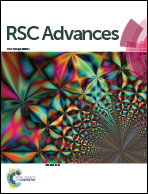Synthesis of UV/blue light-emitting aluminum hydroxide with oxygen vacancy and their application to electrically driven light-emitting diodes†
Abstract
Aluminum hydroxide nanoparticles, one of the essential luminescent materials for display technology, bio-imaging, and sensors due to their non-toxicity, affordable pricing, and rare-earth-free phosphors, are synthesized via a simple method at a reaction time of 10 min at a low temperature of 200 °C. By controlling the precursor's ratio of aluminum acetylacetonate to oleic acid, UV or blue light-emitting aluminum hydroxides with oxygen defects and carbonyl radicals can be synthesized. As a result, aluminum hydroxide (Al(OH)3−x) nanoparticles overwhelmingly emit UVA light (390 nm) because of the oxygen defects in nanoparticles, and carbon-related radicals on the nanoparticles are responsible for the blue-light emission at 465 nm. Electrically driven light-emitting devices are applied using luminescent aluminum hydroxide as an emissive layer, that consists of a cost-efficient inverted bottom-emission structure as [ITO (cathode)/ZnO/emissive layers/2,2′-bis(4-(carbazol-9-yl)phenyl)-biphenyl (BCBP)/MoO3/Al (anode)]. The device with aluminum hydroxide as an emissive layer shows a maximum luminance of 215.48 cd m−2 and external quantum efficiency (EQE) of 0.12%. The new method for synthesizing UV–blue emitting aluminum hydroxides and their application to LEDs will contribute to developing the field of non-toxic optoelectronic material or UV–blue emitting devices.



 Please wait while we load your content...
Please wait while we load your content...